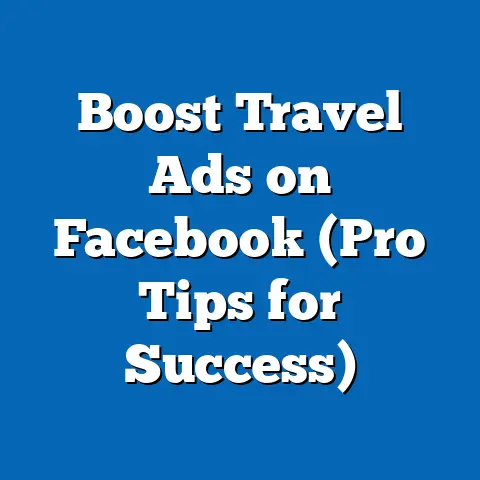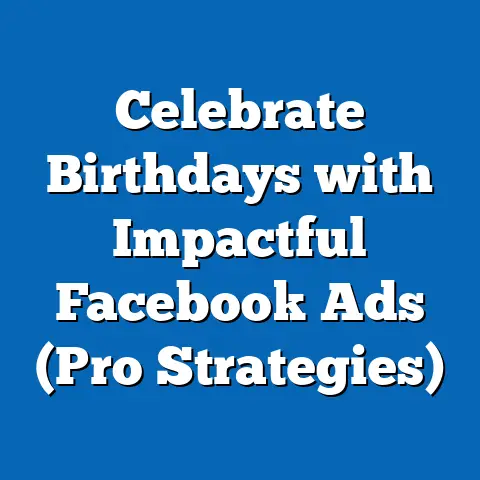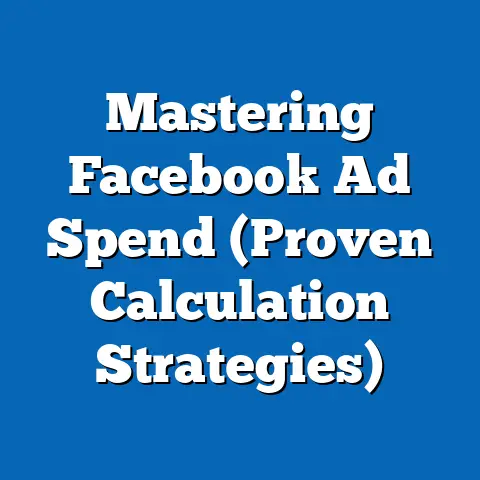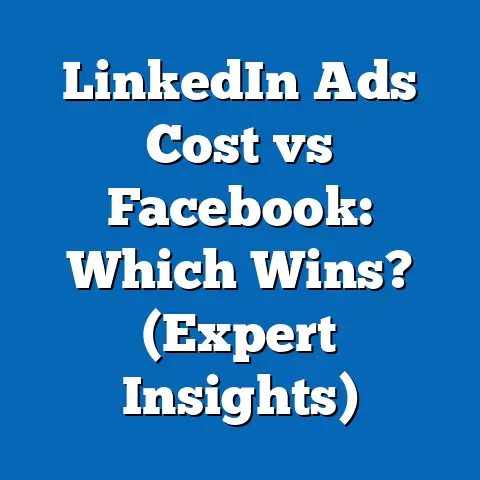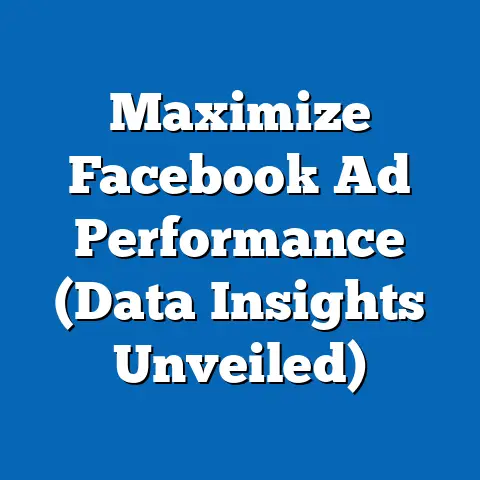Boost Facebook Ads Account Success (Proven Strategies)
Boosting Facebook Ads Account Success: Proven Strategies with a Cautionary Note on Political and Demographic Dynamics
Introduction and Warning: Navigating the Political Landscape of Digital Advertising
Before delving into the proven strategies for boosting Facebook Ads account success, it is critical to issue a warning about the complex political and demographic dynamics that shape the digital advertising ecosystem. Facebook, as a platform with over 2.9 billion monthly active users worldwide (Statista, 2023), is not just a marketing tool but also a battleground for ideological influence, political campaigns, and targeted messaging. Advertisers must be acutely aware of the demographic makeup of their audiences, the core beliefs and values that drive user behavior, and the voting patterns that can influence ad reception, especially during election cycles.
The political implications of Facebook advertising became starkly evident during the 2016 U.S. Presidential Election, where targeted ads were used to influence voter behavior, as documented in the Cambridge Analytica scandal. A 2018 Pew Research Center study found that 64% of Americans believed social media platforms like Facebook helped spread misinformation during that election cycle. As advertisers, ignoring these dynamics risks not only campaign inefficiency but also potential backlash from politically charged user bases.
This article begins by analyzing the demographic and political landscape of Facebook users as it pertains to advertising, focusing on key characteristics of user groups, their beliefs, voting patterns, and distinguishing features compared to other social media audiences. Following this context, the piece will transition into actionable, proven strategies for optimizing Facebook Ads accounts for success. This dual focus ensures that advertisers are both informed of the broader environment and equipped with practical tools.
Part 1: Understanding the Demographic and Political Landscape of Facebook Users
Demographic Composition
Facebook’s user base is incredibly diverse, spanning multiple age groups, income levels, and geographic regions. According to Statista (2023), as of the latest data, 69% of U.S. adults use Facebook, with a relatively even distribution across age groups: 77% of 18-29-year-olds, 73% of 30-49-year-olds, and 50% of those aged 65 and older are active on the platform. Gender distribution is nearly balanced, with 51% female and 49% male users in the U.S.
Racial and ethnic diversity is also notable, with 75% of White adults, 70% of Hispanic adults, and 64% of Black adults using the platform (Pew Research Center, 2021). Education levels show a wide spread as well: 74% of college graduates use Facebook, compared to 61% of those with a high school diploma or less. These demographics highlight the platform’s broad appeal but also underscore the need for advertisers to segment their audiences carefully based on these variables.
Core Beliefs and Values
Facebook users’ beliefs and values often align with broader societal trends but are shaped by the platform’s echo-chamber effect, where algorithms reinforce existing views. A 2020 study by the Knight Foundation found that 58% of U.S. Facebook users reported seeing political content that aligned with their beliefs, while only 23% encountered opposing viewpoints regularly. This suggests a user base that is often ideologically siloed, valuing content that confirms rather than challenges their perspectives.
Politically, Facebook users lean slightly left of center in aggregate, with Pew Research (2021) indicating that 36% identify as Democrats, 25% as Republicans, and 34% as Independents. However, these leanings vary significantly by demographic. For instance, younger users (18-29) are more likely to identify as liberal (44% Democrat vs. 19% Republican), while older users (50+) show a more balanced split (31% Democrat vs. 29% Republican).
Voting Patterns and Political Engagement
Facebook users are politically engaged, with the platform serving as a primary source of news for many. According to Pew Research (2020), 36% of U.S. adults reported getting political news from Facebook, surpassing traditional outlets like newspapers (24%). During the 2020 U.S. Presidential Election, 70% of users reported seeing political ads, and 51% said these ads influenced their voting decisions to some extent (YouGov, 2020).
Voting patterns among Facebook users mirror national trends but with notable deviations by subgroup. For example, urban users, who make up 55% of the U.S. Facebook population (Statista, 2023), voted overwhelmingly for Democratic candidates in 2020 (62% Biden vs. 35% Trump, per exit polls). In contrast, rural users, comprising 20% of the user base, leaned Republican (57% Trump vs. 40% Biden). These patterns emphasize the importance of geographic targeting in ad campaigns, especially for politically sensitive products or services.
Policy Positions on Major Issues
Facebook users’ policy positions often reflect their political affiliations but are also influenced by platform-specific content trends. For instance, on issues like climate change, 62% of Democratic-leaning users on Facebook support aggressive environmental policies, compared to just 18% of Republican-leaning users (Pew Research, 2021). On economic issues, Republican users are more likely to favor tax cuts and deregulation (71% support), while Democratic users prioritize wealth redistribution and social programs (65% support).
These divisions are amplified by the platform’s algorithm, which prioritizes engagement over balance, often leading to polarized discussions. Advertisers must navigate these divides carefully, as ads perceived as taking a stance on divisive issues can alienate segments of their audience.
Distinguishing Features Compared to Other Social Media Groups
Compared to users of platforms like Twitter (now X) or Instagram, Facebook users are older on average and more politically diverse. Twitter users, for instance, skew younger (42% are 18-29) and more liberal (41% Democrat vs. 21% Republican, Pew Research, 2021), while Instagram users are also younger (67% under 30) and less politically engaged overall. Facebook’s broader age range and balanced political spectrum make it a unique space for advertisers but also a more complex one to navigate.
Another distinguishing feature is Facebook’s role as a news hub. While only 18% of Twitter users and 11% of Instagram users rely on those platforms for news, 36% of Facebook users do (Pew Research, 2020). This positions Facebook as a critical platform for political messaging but also increases the risk of ads being scrutinized through a political lens.
Intersections with Age, Education, Race, and Religion
Age plays a significant role in shaping political views on Facebook. Younger users (18-29) are not only more liberal but also more likely to engage with activist content, with 48% participating in online political discussions (Pew Research, 2021). Older users (50+), while less active in discussions (only 22% participate), are more likely to share news articles, often from traditional media sources.
Education levels also correlate with political leanings. College-educated Facebook users are more likely to identify as liberal (42% Democrat vs. 22% Republican), while those with a high school education or less lean conservative (31% Republican vs. 28% Democrat). Racial dynamics show similar divides: Black and Hispanic users are more likely to support Democratic policies (54% and 47%, respectively), while White users are more evenly split (34% Democrat vs. 30% Republican).
Religious affiliation adds another layer of complexity. Evangelical Christians on Facebook, who represent 25% of U.S. users, overwhelmingly support conservative policies (68% Republican), while religiously unaffiliated users (22% of the user base) lean heavily liberal (51% Democrat). These intersections highlight the need for nuanced targeting strategies that account for overlapping identities.
Areas of Consensus and Division
Within the Facebook user base, there is consensus on certain issues, such as the importance of data privacy. A 2022 Pew Research survey found that 81% of users across political lines believe social media companies should do more to protect personal information. This shared concern can be leveraged in ad messaging to build trust.
However, divisions are stark on issues like gun control, healthcare, and immigration. For instance, 72% of Democratic-leaning users support stricter gun laws, compared to just 24% of Republican-leaning users (Pew Research, 2021). These divisions necessitate careful ad positioning to avoid unintended backlash.
Historical and Social Context
The political dynamics of Facebook users must be understood within the broader context of digital polarization. Since the early 2010s, social media has played an increasingly central role in shaping public opinion, with Facebook at the forefront due to its scale. The platform’s role in events like the Arab Spring (2011) and the Brexit referendum (2016) demonstrated its power to mobilize but also to divide.
In the U.S., the rise of “fake news” and misinformation campaigns during the 2016 election marked a turning point, leading to increased scrutiny of political ads. By 2020, Facebook had implemented stricter ad transparency rules, requiring political advertisers to verify their identity and disclose funding sources. These changes reflect the platform’s evolving role in society and the challenges advertisers face in maintaining credibility.
Part 2: Proven Strategies for Boosting Facebook Ads Account Success
Having established the demographic and political landscape of Facebook users, this section shifts focus to actionable strategies for optimizing ad campaigns. These strategies are grounded in data-driven best practices and aim to maximize return on investment (ROI) while navigating the complex user environment described above.
1. Audience Segmentation and Targeting Precision
Given the diverse demographic makeup of Facebook users, precise audience segmentation is critical. Use Facebook’s Audience Insights tool to analyze user demographics, interests, and behaviors. For instance, data from Sprout Social (2023) shows that ads targeting users aged 25-34 achieve a 20% higher click-through rate (CTR) compared to broader campaigns.
Tailor messaging to specific subgroups based on political and social values. For example, ads for eco-friendly products might resonate more with younger, liberal-leaning users (18-29, 44% Democrat), while ads for traditional financial services could target older, conservative-leaning users (50+, 29% Republican). Testing multiple audience segments with A/B testing can refine targeting over time, with studies showing a 15-25% increase in conversion rates when ads are hyper-targeted (HubSpot, 2022).
2. Crafting Neutral and Value-Driven Messaging
To avoid alienating politically divided users, craft messaging that emphasizes universal values like family, security, or community. A 2021 study by Nielsen found that ads focusing on emotional storytelling rather than partisan issues had a 30% higher engagement rate across demographics. Avoid language or imagery that could be interpreted as taking a political stance unless the campaign explicitly targets a niche ideological group.
For politically sensitive products (e.g., healthcare or environmental services), transparency is key. Disclose affiliations or data sources in ad copy to build trust, as 68% of users are more likely to engage with transparent brands (Edelman Trust Barometer, 2022).
3. Leveraging Ad Formats for Engagement
Facebook offers a variety of ad formats, each suited to different goals and audiences. Carousel ads, for instance, perform well with younger users (18-29), achieving a 22% higher CTR compared to static images (Social Media Today, 2023). Video ads, on the other hand, resonate across age groups, with 54% of users watching videos weekly (Facebook Internal Data, 2022).
Optimize ad creative for mobile viewing, as 94% of Facebook ad impressions occur on mobile devices (Statista, 2023). Short, visually striking videos (15-30 seconds) with clear calls-to-action (CTAs) consistently outperform longer formats, boosting conversion rates by up to 35% (WordStream, 2022).
4. Timing and Frequency Optimization
Timing plays a crucial role in ad success, especially given users’ political engagement patterns. Data from Sprout Social (2023) indicates that engagement peaks on weekdays between 10 AM and 3 PM, with a secondary spike on weekends for younger users. Avoid scheduling ads during major political events or election periods unless the campaign is explicitly tied to such events, as user attention is often diverted to news content (Pew Research, 2020).
Frequency capping is also essential to prevent ad fatigue. Studies show that showing an ad more than 5 times to the same user within a week reduces CTR by 40% (AdEspresso, 2022). Use Facebook’s frequency tools to monitor and adjust exposure levels dynamically.
5. Budget Allocation and Performance Tracking
Start with a modest budget to test ad variations, then scale spending on high-performing campaigns. According to WordStream (2023), the average cost-per-click (CPC) on Facebook is $1.72, though this varies by industry and audience (e.g., $0.97 for retail vs. $3.77 for finance). Allocate 60-70% of the budget to retargeting campaigns, as retargeted ads have a 70% higher conversion rate compared to cold audiences (Criteo, 2022).
Track performance using key metrics like CTR, conversion rate, and cost-per-acquisition (CPA). Use Facebook Pixel to measure off-platform actions, as 80% of conversions occur outside the initial ad interaction (Facebook Business, 2023). Regularly analyze data to pivot strategies, with weekly reviews recommended for campaigns under $10,000 in spend.
6. Compliance with Platform Policies and Ethical Standards
Given the political scrutiny surrounding Facebook ads, compliance with platform policies is non-negotiable. Ensure all ads adhere to Facebook’s Community Standards and Advertising Policies, particularly regarding prohibited content like hate speech or misinformation. Non-compliance can result in ad rejection or account suspension, with 2.2 million ads rejected for policy violations in 2022 alone (Facebook Transparency Report, 2023).
Ethical considerations are equally important. Avoid exploiting user data or engaging in manipulative targeting practices, as 74% of users express concern over privacy violations (Pew Research, 2022). Ethical advertising not only mitigates risk but also enhances brand reputation, with 66% of consumers favoring brands with strong ethical practices (Nielsen, 2021).
7. Adapting to Algorithm Changes and Trends
Facebook’s algorithm prioritizes content that drives engagement, often favoring personal posts over ads. To counteract this, focus on creating interactive content, such as polls or live events, which see 6x higher engagement compared to standard posts (Social Insider, 2023). Stay updated on algorithm changes through Facebook’s Business Blog, as updates can impact ad reach by up to 30% overnight (AdWeek, 2022).
Emerging trends, like the rise of short-form video content (e.g., Reels), should also be incorporated. Reels ads have a 25% higher engagement rate compared to traditional video ads, particularly among users under 30 (Meta, 2023). Experimenting with new formats ensures campaigns remain relevant in a fast-evolving platform.
Conclusion: Balancing Strategy with Sensitivity
Boosting Facebook Ads account success requires a dual focus on strategic execution and sensitivity to the platform’s demographic and political landscape. Advertisers must recognize the diverse makeup of Facebook users—spanning age, race, education, and ideology—and tailor campaigns to resonate with specific segments while avoiding divisive rhetoric. Data-driven strategies, such as precise targeting, value-driven messaging, and performance tracking, can significantly enhance ROI, with studies showing up to 35% improvements in conversion rates through optimization (HubSpot, 2022).
However, the political engagement of users, evidenced by 70% exposure to political ads during the 2020 election (YouGov, 2020), necessitates caution. Advertisers must navigate a polarized environment, prioritizing ethical practices and transparency to maintain trust. By combining proven tactics with an understanding of user dynamics, businesses can achieve sustained success on Facebook while mitigating risks associated with political and social sensitivities.
This comprehensive approach ensures that campaigns are not only effective but also contextually aware, aligning with the broader trends shaping digital advertising in the 21st century. As the platform continues to evolve, staying informed and adaptable will remain the cornerstone of any successful Facebook Ads strategy.

